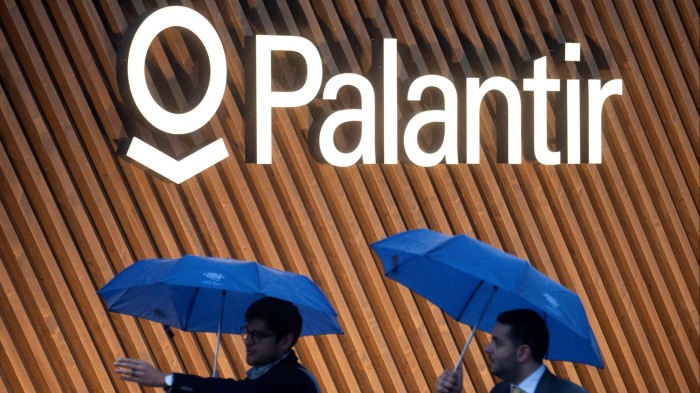Unlock the Editor’s Digest for free
Roula Khalaf, Editor of the FT, selects her favourite stories in this weekly newsletter.
Mass surveillance. Pandemic tracking. Predictive policing. Insurrection detection. Drug testing. Political lobbying. AI deployment. NHS restructuring. Employee snooping. Vaccine rollouts. Spac investment. Referencing Tolkien. It’s hard to avoid priors with Palantir. To do no more than list its activities can make a person sound like a crank and/or co-founder.
That’s why a recent note from Trivariate Research caught our attention. A boutique founded by former hedge fund manager and Morgan Stanley chief US equity strategist Adam Parker, Trivariate rarely does single stocks. When it does, it just does data.
What most interests Parker is not what Palantir does, it’s how much it costs. According to his calculations, Palantir is one of the most expensive US large-cap stocks ever to exist.
Palantir’s $314bn market capitalisation makes it a top-30 constituent of the S&P 500, between Coca-Cola and Bank of America. Its PE ratios look nuts enough — 565x trailing, 228x forward — but they’re as nothing compared with sales multiples.
According to a Trivariate screen of 2000 established US non-financial stocks that goes back to the start of the century, only six have traded at a higher EV-to-forecast-sales ratio than Palantir does today:
Five of the 15 stocks listed above are moonshot biotechs and one is MicroStrategy, which is in its own category of weird. Of those to peak before 2024, not many were good long-term investments.
Comverse Technology was dead by 2013 and its CEO went to jail in 2017, having been on the run for more than a decade. Bluebird Bio was taken private this week for less than a fifth of its 2019 valuation. Moderna is down 94 per cent from its mid-pandemic high. FuelCell Energy’s down 99 per cent in four years, as is Plug Power. Cheniere Energy, an LNG exporter, halved in 2015 then took five years to reclaim the level.
The broader point to make is that enterprise values of 70 times forecasted sales are never normal. Most years, the number of established US stocks hitting just 30 times sales is zero.
Toppy forward valuations only really happened during the dotcom boom and the free-money pandemic era, which makes last year an outlier: Soundhound AI and Astera Labs both joined the >30x sales club in December (and had lost 60 per cent of their value by early April).

Some of these examples are extreme outliers, but stocks on Trivariate’s screen that hit 30 times forecasted sales have underperformed the S&P 500 on average by 22.5 per cent over the next year and ended the period trading at just 18 times sales.
The derating is partly due to multiple compression and partly due to downgraded forecasts. Companies enter the bubble zone after growing annual revenue by 45 per cent on average. Analysts expect them to repeat the trick and are disappointed: year-two average sales growth slows to just 28 per cent.

Where does that leave Palantir?
To find anything comparable you need to go back to the year 2000, when the makers of network widgets and software routinely traded at three-digit sales multiples.
Using trailing revenue rather than forecasts, Parker and team list the top-five most expensive stocks of the dotcom bubble as Ariba, Brocade, Juniper, Verisign and Tibco Software. Things didn’t work out great for them:

Palantir resembles a one-stock bubble. It’s over three times more expensive than the next most expensive company (excluding Strategy) and is forecast to deliver sales growth that’s unprecedented for a company of its size, yet it is no better than what’s available elsewhere for much cheaper:

Parker and team note that the end-June S&P 500 rebalance will raise Palantir’s index weighting over the large-cap threshold, and argue that this will compel active managers to apply some sanity checks:
Palantir may be fundamentally awesome, we don’t know. But we do know that no company has grown fast enough to justify this valuation, and that many companies are forecasted to grow faster according to consensus expectations. For large cap portfolio managers who are going to do new work on this before it hits their index, it’s hard to imagine this looks attractive.
That’s one take. Other analysis is available:
EXCLUSIVE: Alex Jones Responds To The Palantir Hysteria & Lays Out What’s Really Happening pic.twitter.com/dHUvPwH58k
— Alex Jones (@RealAlexJones) June 2, 2025
Further reading:
— Everything is nuts. When’s the crash?

